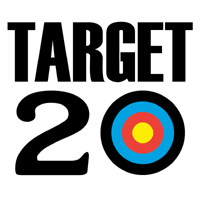
What Is Target 20?
Target 20 is an easy and elegant way to adjudicate combat in classic D&D – without any tables or new statistics, using just the original rules. Here’s the basic idea: Every roll is d20 + level + modifiers, with a result of 20 or more indicating success.
Easy, right? Many DMs have been using this to simplify their games for years now. The mechanic is purely additive, which most people find easier than an inverse-subtraction method (e.g., THACO). The target is always 20, and AC is just another added modifier – there’s no need to invent a new target score for every opponent or skill check (e.g., as in the d20 System). Here’s some more detail:
Attack Rolls
Attacks are resolved by rolling d20 + fighter level + modifiers + target AC (success on 20 or more). For actual fighters and monsters, the base addition is just their level or hit dice (for other classes, we take a ratio: ⅔ level for clerics and thieves; ½ level for wizards). Players may wish to document their total attack adjustments; but the DM doesn’t need any new stats, because they just add the HD value for any attacking monsters. When PCs attack a monster, we usually keep the AC secret and add it mentally after the player announces their roll; note that using the classic descending AC means that the better the armor, the less an attacker gets to add.
Saving Throws
Saving throws work likewise: roll d20 + character level + modifiers (success on 20 or more). The modifiers in this case are by type of save: +0 vs. spells, +1 vs. breath, +2 vs. stone, +3 vs. wands, +4 vs. death. With this simplification, we don’t even bother to record saving scores on PC sheets anymore.
Thief Skills
Thief skills get the same treatment: roll d20 + thief level + modifiers (success on 20 or more). We grant the thief’s Dexterity modifier as a bonus to this roll. We don’t even bother writing down separate skill categories with this streamlining.
How Accurate Is It?
In 2018 we learned that the pre-publication draft of the original D&D rules used no combat tables, and was instead based on a simple formula equivalent to the one we have here. You'll see a link from that site back to our blog, where we deduced this fact a decade or more prior. Compared to the table versions that we do see in the official books, Target 20 tends to produce results, on average, within 1 or 2 pips (regardless of which classic edition you use). For example, with attacks, the results are identical to Original D&D at 1st level, and grow a bit more generous with advancing levels. Likewise, for thief skills (assuming a 1 or 2 point Dexterity bonus), results are identical to OD&D at 1st level, and then fall slightly behind at higher levels. For a more detailed statistical analysis, please visit our blog.
How Can I Get Started?
There’s nothing new you need to add to your game. Just start adding level + classic AC, and look for that magic number 20. No tables required, no new statistical documentation, and no reverse-subtractions of modifiers.
But if you’re writing a new game product, and want to indicate that you expect use of Target 20 with it, then feel free to use the compatibility mark image at the top of this page! (And maybe also a link to this explanatory site.) Questions are welcome at the address below. We hope that makes your classic D&D game even more furious and fast-paced. Fight on!
